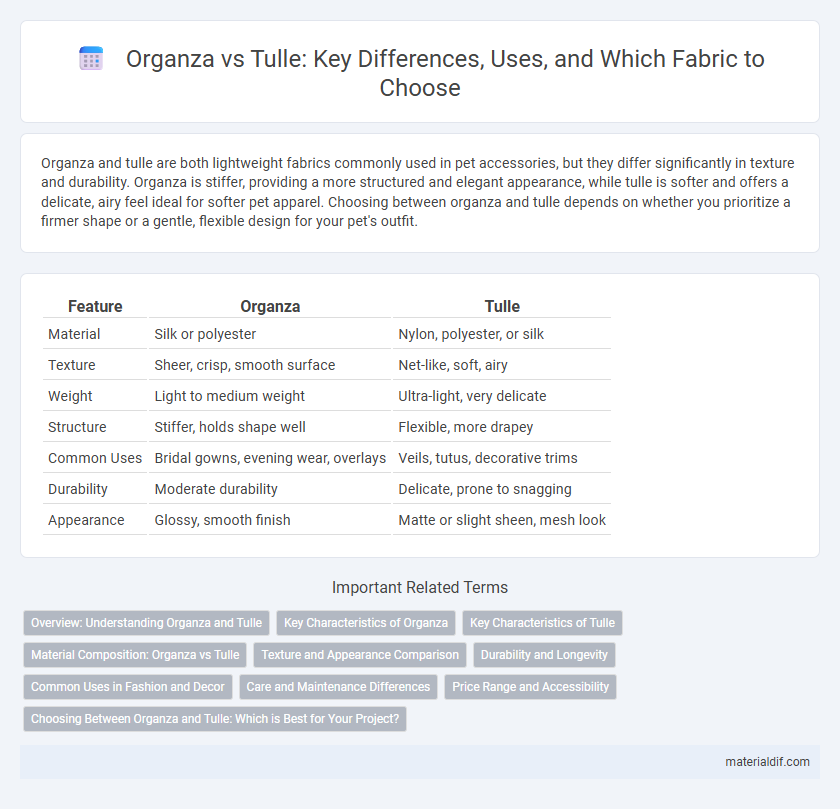Organza and tulle are both lightweight fabrics commonly used in pet accessories, but they differ significantly in texture and durability. Organza is stiffer, providing a more structured and elegant appearance, while tulle is softer and offers a delicate, airy feel ideal for softer pet apparel. Choosing between organza and tulle depends on whether you prioritize a firmer shape or a gentle, flexible design for your pet's outfit.
Table of Comparison
| Feature | Organza | Tulle |
|---|---|---|
| Material | Silk or polyester | Nylon, polyester, or silk |
| Texture | Sheer, crisp, smooth surface | Net-like, soft, airy |
| Weight | Light to medium weight | Ultra-light, very delicate |
| Structure | Stiffer, holds shape well | Flexible, more drapey |
| Common Uses | Bridal gowns, evening wear, overlays | Veils, tutus, decorative trims |
| Durability | Moderate durability | Delicate, prone to snagging |
| Appearance | Glossy, smooth finish | Matte or slight sheen, mesh look |
Overview: Understanding Organza and Tulle
Organza is a lightweight, sheer fabric made from silk or synthetic fibers, known for its crisp texture and slight sheen, often used in eveningwear and bridal gowns. Tulle is a fine netting fabric made from silk, nylon, or polyester, characterized by its soft, airy structure and is commonly used for veils, tutus, and decorative overlays. Both fabrics offer transparency and volume, but organza provides a stiffer finish while tulle is more flexible and delicate.
Key Characteristics of Organza
Organza is a lightweight, sheer fabric known for its crisp texture and smooth finish, often made from silk or synthetic fibers like polyester. It holds structured shapes well, making it ideal for bridal wear and evening gowns where volume and elegance are desired. Unlike tulle, organza has a stiffer hand and a subtle sheen, contributing to its luxurious appearance and durability.
Key Characteristics of Tulle
Tulle is a lightweight, sheer fabric with a fine hexagonal mesh structure, commonly made from silk, nylon, or polyester. Its key characteristics include a delicate, airy texture and excellent stiffness, which allows it to hold shapes well, making it ideal for voluminous skirts, veils, and decorative overlays. Unlike organza, tulle is more flexible and less shiny, providing a softer, more ethereal appearance in garments and decorations.
Material Composition: Organza vs Tulle
Organza is typically made from silk, polyester, or nylon, offering a crisp and slightly stiff texture that holds shape well, making it ideal for structured garments. Tulle is commonly crafted from nylon, polyester, or silk, characterized by its fine netting structure that provides lightweight, sheer coverage with more flexibility than organza. The distinct material composition influences durability, texture, and draping properties, with organza providing a smoother finish and tulle delivering more volume and breathability.
Texture and Appearance Comparison
Organza features a smooth, crisp texture with a lightweight, sheer appearance that reflects light, creating a subtle shimmer ideal for formalwear and elegant overlays. Tulle offers a finer, net-like texture with a soft, airy feel and matte finish, often used for volume in skirts, veils, and tutus due to its lightweight stiffness. Both fabrics provide transparency, but organza's rigidity and sheen contrast with tulle's delicate, mesh-like structure and diffuse look.
Durability and Longevity
Organza is a tightly woven, crisp fabric made from silk or synthetic fibers, offering greater durability and resistance to tearing compared to the delicate netting structure of tulle. Tulle, characterized by its lightweight mesh composition, is more prone to snagging and wear over time, making it less suitable for long-term use. For garments or decorations requiring lasting strength, organza provides enhanced longevity and structural integrity.
Common Uses in Fashion and Decor
Organza is commonly used in high-end fashion for structured gowns, bridalwear, and evening dresses due to its crisp and sheer texture that holds shape well. Tulle is favored for creating volumized skirts, veils, and decorative overlays in both fashion and wedding decor because of its lightweight, soft netting and airy appearance. In home decor, organza is often chosen for elegant curtains and table runners, while tulle is preferred for whimsical event decorations like chair sashes and draped backdrops.
Care and Maintenance Differences
Organza requires gentle hand washing with mild detergent and should be air-dried to maintain its delicate, crisp texture, while avoiding wringing or high heat. Tulle, being more resilient and stretchy, can often withstand gentle machine washing in a mesh bag on a delicate cycle, but also benefits from air drying to prevent distortion. Proper storage in a cool, dry place away from direct sunlight preserves the structural integrity and appearance of both lightweight fabrics.
Price Range and Accessibility
Organza typically ranges from $10 to $30 per yard, offering a slightly more luxurious and crisp texture, while tulle is more budget-friendly, averaging between $5 to $15 per yard. Organza is readily available in fabric and specialty stores, often preferred for formal wear due to its stiffness and sheen. Tulle is highly accessible, found in a wide variety of colors and styles at craft stores and online retailers, making it ideal for affordable costumes, decorations, and veils.
Choosing Between Organza and Tulle: Which is Best for Your Project?
Organza offers a crisp, lightweight texture with a subtle sheen, ideal for structured garments and elegant overlays, while tulle provides a softer, more flexible netting perfect for volume and delicate layering. Consider organza for projects requiring stiffness and form, such as bridal gowns or decorative accents, and choose tulle for airy effects in tutus, veils, or costume designs. The decision hinges on the desired fabric behavior, drape, and the project's aesthetic requirements.
Organza vs Tulle Infographic

 materialdif.com
materialdif.com